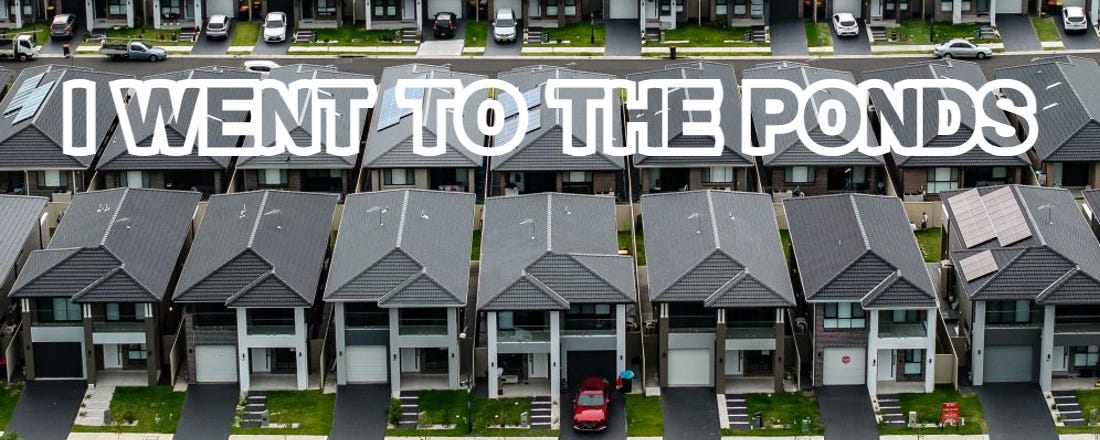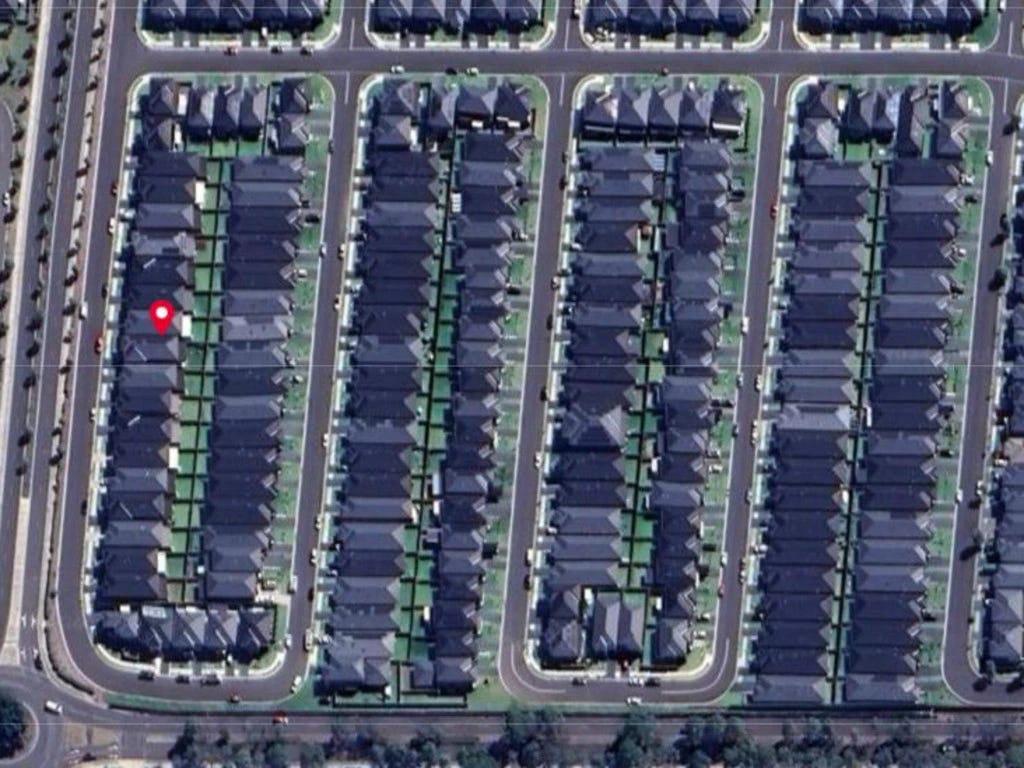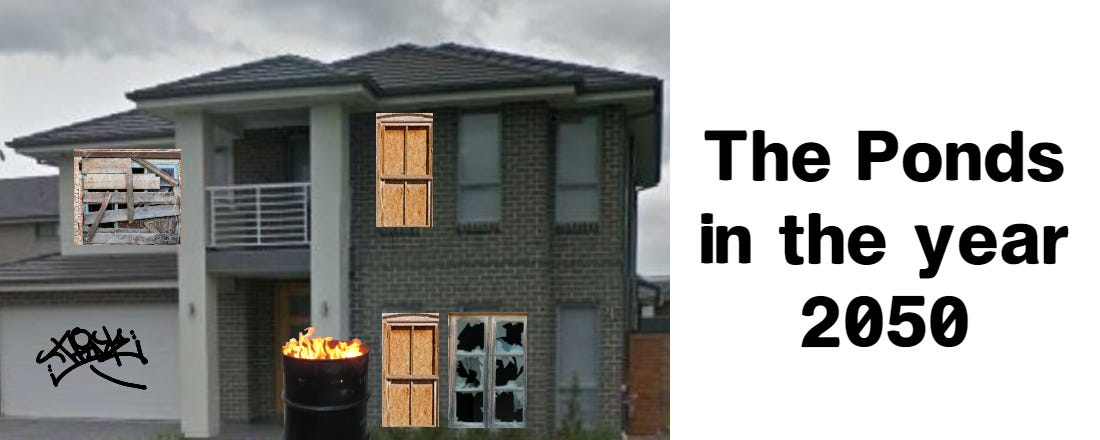I did it, I went to The Ponds. It took a god-awful amount of time to get there, but I got there. It was a truly painful experience, and I’ve come to the conclusion that it literally wouldn’t be possible to live in a place like this without a car.
I woke up to a chilly Saturday morning. My window was slightly open, and I could hear the whistling of wind coming through my unit, mixed with the faint sound of my neighbors still partying from the night before. I got up to close my window. I love sleeping in the cold, but not that cold. I quickly got back into bed and stared at my ceiling, half trying to make out the murmurs of two girls gossiping in a stairwell outside my window, half studying the marks on my ceiling. The mold on my roof is starting to get too bad to ignore. I hate the rain.
Fuck.
I told myself I was going to explore that weird suburb today.
Am I actually going to dedicate a whole day to this?
Yes, I need to see this place with my own eyes.
I poured a coffee, found my vape, got back into bed, and looked up how I was going to reach this remote part of Sydney’s suburbia.
The Ponds is a suburb 40 kilometers northwest of the city. It was part of Kellyville until 2007 and has been the site of heavy property development for the last 15 years. Suburbs like The Ponds are the newest vision for suburban living in modern Australia.
North West Sydney, also known as the Hills District, is quite well known for its, well, let’s just say “calmness.” It’s a non-offensive, suburban, family-oriented region of Sydney. Home to Hillsong Megachurch, RSLs, and seemingly endless roads of well-kept homes, the Hills is well known for being mundane. So, why go there?
A few days ago, The Ponds came to my attention while scrolling through TikTok. I was taken aback by one specific aerial image of the suburb. It just looked so sterile, so Truman Show, so artificial. Is this really in Sydney? I thought it was an AI image at first, but upon further research, I came to learn that this place is very real.
I went to Instagram to ask my followers about their experiences with the suburb, and they pretty much unanimously said the place was as dystopian as it looked.
I have to see this place with my own eyes.
I finished my last sip of coffee and jumped into the shower to get ready for the most boring expedition one man has ever ventured on.
As I left my apartment and walked to Kings Cross station, I couldn't help but feel a sense of the unknown. As I walked up Darlinghurst Rd, I watched a kaleidoscope of different faces go by me on the busy street. Each passing face felt like a different version of the inner city. The homeless man known by some as ‘Mr. Motherfucker,’ wearing an oversized bow-tie for some reason, the good-looking middle-aged woman catching up with a girlfriend, the French Uber Eats riders huddled together outside Macca's waiting for an order. I was leaving my fellow city-rats and entering the daunting world of suburbia.
I got to Town Hall station and jumped on the express to Parramatta. I love the express trains. They ride a few rails away from the usual Inner West platforms, and they just glide through all these nostalgic stations where so many of my early memories have been made. In no time, I was past the Inner West. It was such a frosty day that the almost-empty carriage felt like a warm, cozy caravan hurtling deeper and deeper into the interior of Sydney.
I had reached Western Sydney sooner than I expected. I was making good time and was well ahead of the Google Maps estimated arrival. Arts students and tourists were replaced with large families of new Australians trying to keep all their kids within arm's reach and tradies finishing a long night of roadworks. By the time I reached Parramatta, the sleepy carriage had turned into a chorus of families, tradies on the phone, and teenage boys laughing at whatever teenage boys laugh about these days.
The station was absolutely packed. I know this is meant to be the second CBD of Sydney, but is this place always so packed on a Saturday? There was a five-minute line just to get to the gates to leave the station. What’s going on? If this is what these westies always have to put up with, no wonder they have it out for us city people. I'd be pissed off too.
Oh no.
As I slowly shuffled closer to the gates, amidst a sea of frustrated commuters, I realized why there seemed to be so much chaos.
Fuck my life.
There it was, like the mold on my roof earlier that morning. The yellow sign, planted front and center, just stood there like it had a smirk on its face, ready to ruin anyone and everyone’s day.
Track work.
I gritted my teeth and looked for which bus I would need to catch to Blacktown for the next stop on my journey. I walked out into the chaotic bus depot, everyone frantically looking at each bus, trying to decipher which one to get. I approached my bus and was met with a tough-looking bus lady who told me the one further up is the express to Blacktown. Me and two adorable 4’11" Indian women, about to start their shift at IGA, jogged up to the white coach. Once we got to the door, we were confronted with a driver who yelled at us in broken English, telling us the bus was full as he closed the door on our faces. We ran back to our original bus, hoping it wouldn’t leave without us. We just made it.
I kid you not, the bus must have been stuck in traffic for 40 minutes. There were roadworks for almost the entire journey. I was squashed up next to a friendly-looking older man. The poor guy was trying to drink his V energy drink when it slipped out of his hand, and a light splash of it landed on me. He was so apologetic the entire way. He spent a few minutes rummaging through his bag.
“I know I have a tissue in here somewhere. I’m so sorry, please let me find this tissue for you,” said the flustered older Southeast Asian man.
I told him it wasn’t a big deal, but I think he felt really bad. We still had a long wait in traffic together before I got to Blacktown.
Once I arrived at Blacktown station, I made my way to the platform.
Okay, only 3 stops to Schofields, and then a short bus to The Ponds. It’s nearly over.
I can’t believe I thought I was making good time at Parramatta. I could have flown to Melbourne and back by now.
I got to Schofields and was already in a different world. I wasn’t in the chaos of Western Sydney anymore. I was on the edge of the Hills District, and suddenly, I was alone. I could feel it—the crisp air of the outer edges of civilization filled my lungs. It was clean, but barren, everywhere I looked.
I hopped on the 734 bus and was finally about to lay my eyes on this rogue Sydney suburb.
This has to be it. I looked out of the window to my right and saw a lawn—not just any lawn, though. It was the biggest goddamn lawn I have ever seen in my life.
The story goes that this old Maltese man has owned the place forever, back when it was all farmland. Once the big developers decided they were going to pave over the area, most property owners accepted the generous offers being made for their land, except for this guy. What we have now is a cookie-cutter suburb with a lawn that could fit up to 24 houses, smack in the middle.
I jumped off the bus to have a closer look. It was impressive—if you saw the video on my story, it really doesn’t do justice to just how big this lawn was. You had to squint just to see his front door. It must have been a 120-meter long front yard, maybe more. The house stood there in the wind as a testament to just how stubborn an elderly Maltese man can be when you try to end his Australian dream. The guy had been offered 50 million dollars for the land, so you have to respect it. My excitement of being in front of a home I had been so curious about for the past two days slowly settled. Unfortunately, excitement stayed low for the rest of the expedition.
I looked around at a truly desolate suburb. Both sides of a 200-meter long road were filled with identical gray houses. You could almost envision a tumbleweed passing through on such a cold, windy, gray day. I was surrounded by houses, usually symbols of human life, but there was absolutely no life to be seen whatsoever. It was clear people were living in these homes, but I was truly shocked at how quiet the streets were. I couldn’t even hear noises coming from inside the homes.
It was almost as if the entire suburb had been warned of my arrival and had decided to hunker down and not make a sound until the outsider left. It was Saturday—surely there would be at least some car movement? I saw two cars in the 30 minutes I was walking around.
I felt a sense of sadness for both what was once beautiful farmland and also for the people who had moved in. A lot of the people living in these homes are from India and China—communal societies where knowing everyone on your street is completely normal. The Australian dream they were sold was just as much a rip-off as the underprovided area they had bought into. Instead of the bustling streets in their home countries filled with life, both young and old, they were living on the outskirts of Sydney, in a suburb that was advertised to them as a prestigious new area. This area might have ‘prestige’ to someone, somewhere, but that’s about it. These places have zero shops, barely any public transport, and no entertainment within walking distance. This bizarre cookie-cutter suburb, with no trees, no backyards, and no character, was almost like a symbol for what not only new arrivals can expect but also young Australians trying to enter the housing market.
As I walked the streets and talked to my phone for my Instagram followers, I couldn’t help but lower my voice. It was so quiet that I felt like speaking was disturbing the peace. I felt like if I talked too loudly, an angry old man would come out—and honestly, I would have loved that. It would have at least been a bit of life.
Ironically, only a few suburbs over in Blacktown, I was being flooded with life. Maybe these more ‘well-to-do’ migrants don’t want that? Maybe this is what they think Australia is all about.
The longer I spent in this flat, endless landscape of gray homes, the more disoriented I became. “Wait, I’ve been on this street already, haven’t I?” I kept thinking to myself.
I understand I’m coming from a pretty urban bubble, but I know for a fact that the people from Western Sydney, not far from here, with totally different perspectives on this city, would feel the exact same way about this strange suburb.
Australia’s population is growing rapidly, which is something I welcome. We have the space and money for it. This article isn’t trying to come up with the solution for that, but one thing I know for sure is that The Ponds definitely isn't it.
My journey from the Inner City of Sydney through the Western Suburbs and up into the outskirts of the Hills District reconfirmed the fact that Sydney is a divided city, not just in geography, but in the people and our realities. The Ponds is one version of what many believe to be the ‘Australian dream.’ It isn’t the only suburb like this. Throughout the outer regions of Sydney, there are suburbs like this being built under the guise of providing for an increasing population, by gung-ho property developers who are making the most of lax regulations. It’s hard to tell if these soulless suburbs, like The Ponds, will one day grow into themselves. I’m sure there was a time when many well-loved suburbs once felt soulless. Unfortunately, with bad infrastructure, zero community, a lack of public transport, and no entertainment, it’s not hard for me to imagine that suburbs like The Ponds may be viewed as the new ‘ghettos’ of Sydney in a few decades.








Get on to the property ladder they said. Ladder being another term for pyramid scheme. Developers had the opportunity to create a paradise from a blank space, but consumed by greed they have sparked a zombie town. I live next door to Nemo's dentist, you should come visit one day. Our area is in a hot battle against greedy developers.